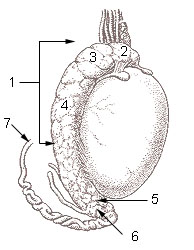Anatomy of the Testis
Paired Organ: Yes.
Each testicle is considered a separate site unless bilateral involvement is stated to be metastatic from one side to the other.
Key words
- Leydig cells
Secretes testosterone - Tunica albuginea
A dense capsule encasing each testis; inhibits direct extension of tumor - Rete (ree' tee) testis
Network of efferent ducts, analagous to the pelvis of the kidney - Epididymis
Storage vessel for sperm—long, coiled tube external to testis - Vas deferens (ductus deferens)
Muscular extension of epididymis, which carries sperm to urethra
The two testicles are egg-shaped male reproductive glands. They are suspended in a pouch of loose skin called the scrotum below and behind the penis. In maturity, they are usually slightly smaller than a golf ball. It is normal for one testicle to be larger than the other
The testicles produce the hormone testosterone as well as sperm, the male reproductive cells.
Testicle and Epididymis, Surface

- Epididymis
- Head of epididymis
- Lobules of epididymis
- Body of epididymis
- Tail of epididymis
- Duct of epididymis
- Deferent duct (ductus deferens or vas deferens)
The epididymis is a narrow, tightly-coiled tube connecting rear of the testicles to the deferent duct (ductus deferens or vas deferens).
The epididymis consists of three parts: head, body, and tail. The head of the epididymis is located on superior pole of testis. It stores sperm for maturation. The body of the epididymis is a highly convoluted duct which connects the head to the tail of the epididymis. Sperm mature in this section of the epididymis. The tail of the epididymis is continuous with the deferent duct.
The deferent duct is the excretory duct of the testis which joins the excretory duct of the seminal vesicle to form the ejaculatory duct.
Suggested Citation
SEER Training Modules: Anatomy of the Testis. U.S. National Institutes of Health, National Cancer Institute. Cited 21 December 2025. Available from: https://training.seer.cancer.gov.




